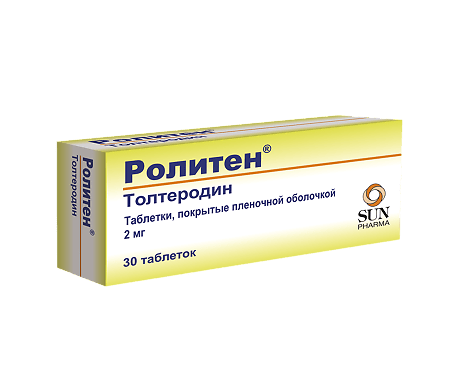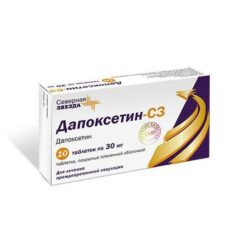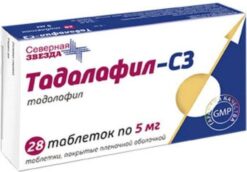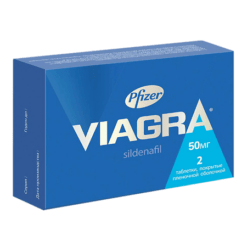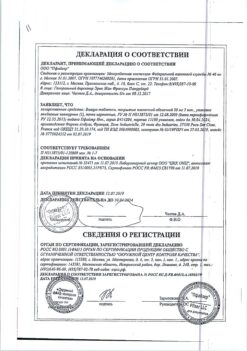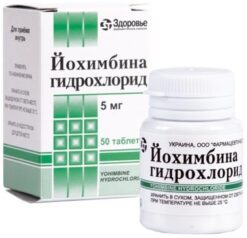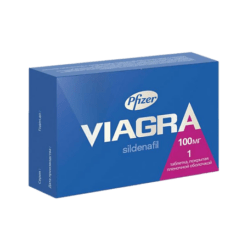No products in the cart.
Roliten, 2 mg 30 pcs.
€1.00
Out of stock
(E-mail when Stock is available)
Description
Roliten has a cholinolytic and antispasmodic effect.
Pharmacodynamics
An antagonist of m-cholinoreceptors localized in the bladder and salivary glands. Reduces the contractile function of the bladder and reduces salivation. Causes incomplete emptying of the bladder, increases the amount of residual urine and reduces detrusor pressure. Permanent therapeutic effect of Tolterodin is achieved after 4 weeks. Tolterodine and its active metabolite 5-hydroxymethyl are highly specific for muscarinic receptors and are selective for bladder receptors (compared to salivary gland receptors).
Pharmacokinetics
Intake. After oral administration of the drug, tolterodine is rapidly absorbed from the gastrointestinal tract. Cmax in serum is reached after 1-3 hours. The Cmax value increases in proportion to the tolterodine dose between 1 and 4 mg. Absolute bioavailability of tolterodine is 65% in persons with decreased metabolism (deprived of CYP2D6) and 17% in persons with increased metabolism (most patients).
Food has no effect on the exposure of unbound tolterodine and the active 5-hydroxymethyl metabolite in those with increased metabolism, although levels of tolterodine are increased when taken with meals.
Distribution. Equilibrium concentration is reached within 2 days. The volume of distribution of tolterodine is 113 liters.
Metabolism. Tolterodine is mainly metabolized in the liver by the polymorphic enzyme CYP2D6 to form the pharmacologically active 5-hydroxymethyl metabolite. In persons with reduced metabolism (with CYP2D6 deficiency) tolterodine undergoes dealkylation by CYP3A4 isoenzymes to form N-dealkylated tolterodine which has no pharmacological activity.
Tolterodine and the 5-hydroxymethyl metabolite bind predominantly to orosomucoid; the unbound fractions are 3.7% and 36%, respectively.
Elimation. Systemic clearance of tolterodine in persons with increased metabolism is about 30 L/h, and T1/2 is 2-3 h. The T1/2 of the 5-hydroxymethyl metabolite is 3-4 h. After administration of 14C-tolterodine, approximately 77% of the radioactive label is excreted in the urine and 17% in the feces, with less than 1% unchanged and about 4% as an active metabolite. The carboxylated metabolite and its corresponding dealkylated metabolite account for about 51% and 29% of what is excreted with the urine.
Pharmacokinetics in special clinical cases. Decreased clearance and prolongation of T1/2 (up to 10 h) of tolterodine in persons with decreased metabolism leads to an increase in its concentration (approximately 7-fold) against undetectable concentrations of the 5-hydroxymethyl metabolite. As a consequence, the AUC value of tolterodine in patients with reduced metabolism is close to the sum of the AUC values of tolterodine and its active 5-hydroxymethyl metabolite in patients with increased metabolism with the same dosing regimen. Consequently, the safety, tolerability and clinical effect of the drug are the same regardless of the phenotype.
The AUC value of tolterodine and its active 5-hydroxymethyl metabolite is increased approximately 2-fold in patients with cirrhosis.
Indications
Indications
Hyperreflexia (hyperactivity, instability) of the bladder, manifested by frequent, imperative urge to urinate and/or urinary incontinence.
Pharmacological effect
Pharmacological effect
Roliten has anticholinergic and antispasmodic effects.
Pharmacodynamics
Antagonist of m-cholinergic receptors localized in the bladder and salivary glands. Reduces the contractile function of the bladder and reduces salivation. Causes incomplete emptying of the bladder, increases the amount of residual urine and reduces detrusor pressure. A persistent therapeutic effect of tolterodine is achieved after 4 weeks. Tolterodine and its active metabolite 5-hydroxymethyl are highly specific for muscarinic receptors and have selectivity for bladder receptors (compared to salivary gland receptors).
Pharmacokinetics
Suction. After taking the drug orally, tolterodine is rapidly absorbed from the gastrointestinal tract. Serum Cmax is reached within 1–3 hours. The Cmax value increases in proportion to the dose of tolterodine in the range from 1 to 4 mg. The absolute bioavailability of tolterodine is 65% in poor metabolizers (those lacking CYP2D6) and 17% in increased metabolizers (most patients).
Food does not affect exposure to unbound tolterodine and the active 5-hydroxymethyl metabolite in advanced metabolizers, although tolterodine levels increase when taken with food.
Distribution. Equilibrium concentration is achieved within 2 days. The volume of distribution of tolterodine is 113 l.
Metabolism. Tolterodine is primarily metabolized in the liver by the polymorphic enzyme CYP2D6 to form a pharmacologically active 5-hydroxymethyl metabolite. In individuals with reduced metabolism (CYP2D6 deficiency), tolterodine undergoes dealkylation by CYP3A4 isoenzymes to form N-dealkylated tolterodine, which has no pharmacological activity.
Tolterodine and the 5-hydroxymethyl metabolite bind predominantly to the orosomucoid; unbound fractions account for 3.7 and 36%, respectively.
Excretion. The systemic clearance of tolterodine in persons with increased metabolism is about 30 l/h, and T1/2 is 2–3 hours. T1/2 of the 5-hydroxymethyl metabolite is 3–4 hours. After administration of 14C-tolterodine, approximately 77% of the radioactive tracer is excreted in the urine and 17% in feces, with less than 1% unchanged and about 4% – in the form of an active metabolite. The carboxylated metabolite and its corresponding dealkylated metabolite account for about 51 and 29% of the amount excreted in the urine.
Pharmacokinetics in special clinical cases. A decrease in clearance and prolongation of T1/2 (up to 10 hours) of tolterodine in individuals with reduced metabolism leads to an increase in its concentration (about 7 times) against the background of undetectable concentrations of the 5-hydroxymethyl metabolite. As a result, the AUC value of tolterodine in patients with reduced metabolism is close to the sum of the AUC values of tolterodine and its active 5-hydroxymethyl metabolite in patients with increased metabolism at the same dosage regimen. Therefore, the safety, tolerability and clinical effect of the drug are the same, regardless of the phenotype.
The AUC value of tolterodine and its active 5-hydroxymethyl metabolite increases approximately 2-fold in patients with liver cirrhosis.
Special instructions
Special instructions
Before starting treatment, organic causes of frequent and imperative urination should be excluded.
Roliten is not recommended for use in children, since the safety and effectiveness of the drug in this category of patients have not been studied at present.
Women of childbearing potential should use reliable methods of contraception during therapy with Rolitene.
Influence on the ability to drive a car and operate machinery. Since Roliten can cause accommodation disturbances and reduce the speed of psychomotor reactions, the question of the possibility of engaging in potentially hazardous activities should be decided only after assessing the patient’s individual response to the drug.
Active ingredient
Active ingredient
Tolterodine
Composition
Composition
Active ingredient:
tolterodine tartrate 2 mg;
Excipients:
MCC;
calcium hydrogen phosphate;
sodium carboxymethyl starch (type A);
colloidal silicon dioxide;
magnesium stearate;
Film casing:
Opadry white dye (OY-S-58910) (contains: hypromellose, titanium dioxide, macrogol 400, talc); purified water
Contraindications
Contraindications
hypersensitivity;
urinary retention;
angle-closure glaucoma (not curable);
myasthenia gravis;
ulcerative colitis;
megacolon;
pregnancy;
lactation period;
childhood.
With caution: urinary tract obstruction, obstructive gastrointestinal lesions, neuropathy, irreducible hernia.
Side Effects
Side Effects
From the digestive system: not often – dyspepsia, constipation, abdominal pain, flatulence, vomiting; rarely – gastroesophageal reflux.
From the central nervous system and peripheral nervous system: not often – headache, dizziness, drowsiness, nervousness, paresthesia; rarely – disturbances of consciousness.
Other: not often – weakness, fatigue, weight gain; rarely – chest pain; allergic reactions, flushes of blood to the skin of the face.
Interaction
Interaction
When Roliten is used in combination with other drugs that have anticholinergic properties, the therapeutic effect and undesirable effects may be enhanced.
When Roliten is used simultaneously with m-cholinomimetics, the therapeutic effect of the drug may be reduced.
When Roliten is used in combination with metoclopramide and cisapride, the effect of the latter may be weakened.
Pharmacokinetic interaction with other drugs that are metabolized by the cytochrome P450 system (CYP2D6 or CYP3A4) or inhibit them is possible. However, co-administration of Rolitene with fluoxetine (a strong CYP2D6 inhibitor that is metabolized to norfluoxetine, which is a CYP3A4 inhibitor) results in only a slight increase in the total AUC of tolterodine and its active 5-hydroxymethyl metabolite, which does not cause a clinically significant interaction.
Concomitant treatment with strong CYP3A4 inhibitors such as macrolide antibiotics (erythromycin and clarithromycin) or antifungals (ketoconazole, itraconazole and miconazole) should be avoided.
Clinical trials have shown no interaction between Roliten and warfarin or combined oral contraceptives (containing ethinyl estradiol/levonorgestrel).
A clinical study using metabolic probes did not provide any indication that tolterodine is capable of inhibiting the activity of CYP2D6, CYP2C19, CYP3A4 or CYP1A2.
Overdose
Overdose
Symptoms: disturbances of accommodation and painful urge to urinate. Possible hallucinations, severe agitation, convulsions, respiratory failure, tachycardia, urinary retention, dilated pupils.
Treatment: gastric lavage, administration of activated charcoal, symptomatic therapy: for pronounced central anticholinergic effects (including hallucinations) – physostigmine; for convulsions or severe agitation – benzodiazepines; for tachycardia – beta-blockers; in case of respiratory failure – artificial respiration; for urinary retention – catheterization; if the pupils are dilated, use pilocarpine in the form of eye drops and/or transfer the patient to a dark room.
Storage conditions
Storage conditions
In a dry place, at a temperature not exceeding 25 °C.
Shelf life
Shelf life
2 years
Manufacturer
Manufacturer
Sun Pharmaceutical Industries Ltd, India
Additional information
| Shelf life | 2 years |
|---|---|
| Conditions of storage | In a dry place at a temperature not exceeding 25 °C. |
| Manufacturer | Sun Pharmaceutical Industries Ltd, India |
| Medication form | pills |
| Brand | Sun Pharmaceutical Industries Ltd |
Related products
Buy Roliten, 2 mg 30 pcs. with delivery to USA, UK, Europe and over 120 other countries.

